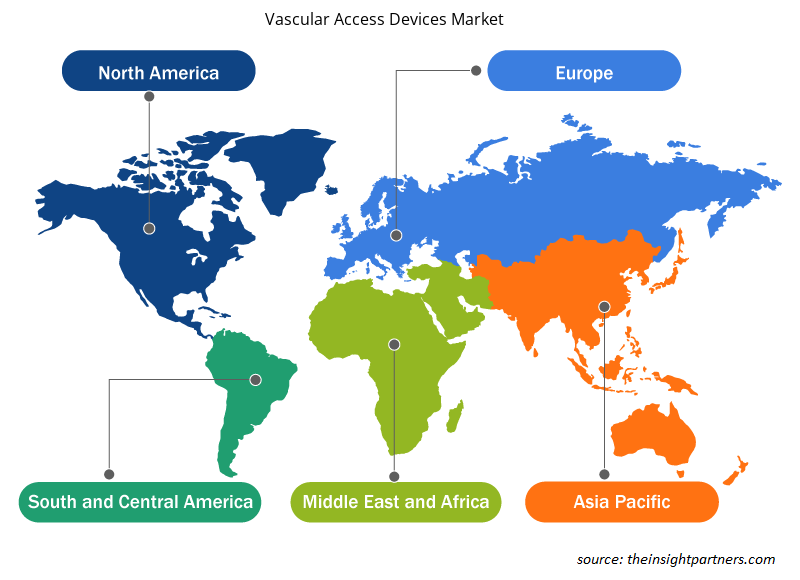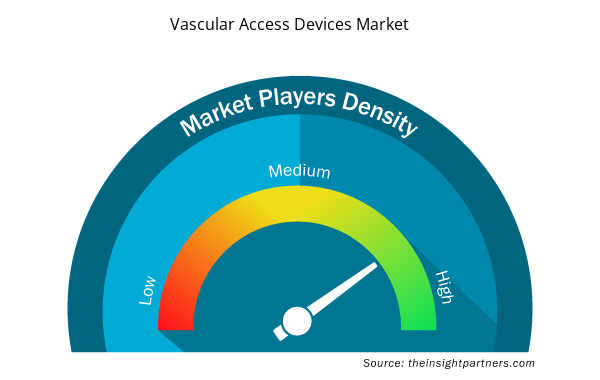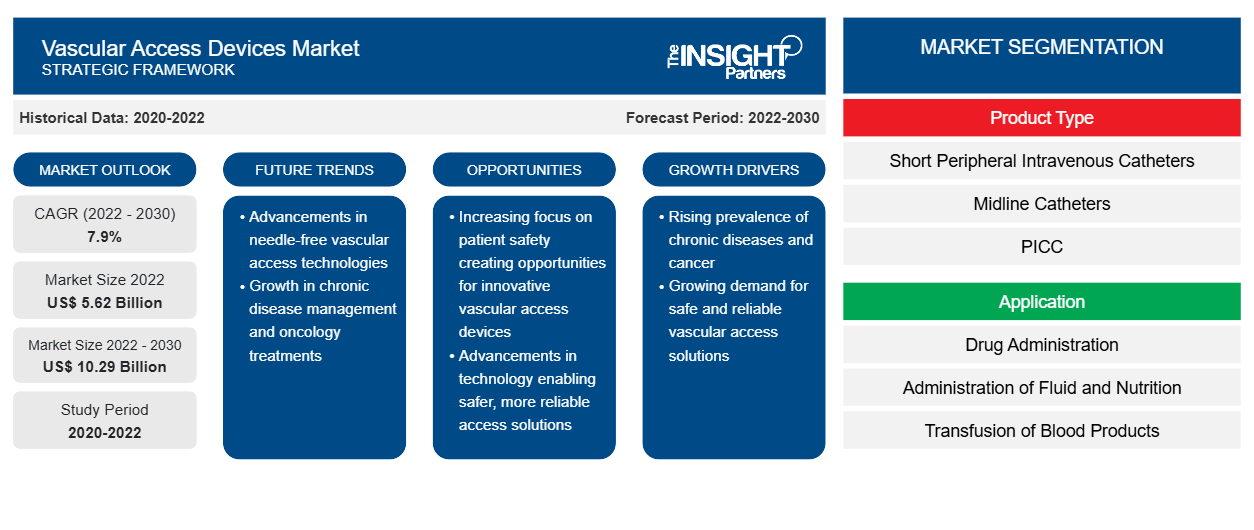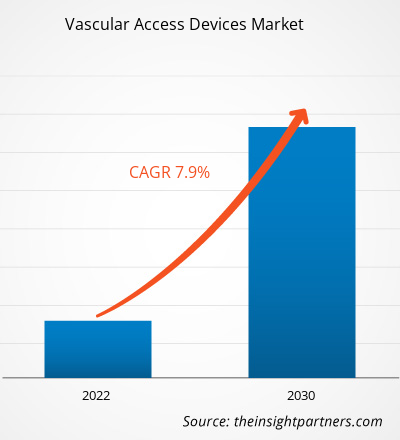[Informe de investigación] El mercado de dispositivos de acceso vascular se valoró en 5.620 millones de dólares estadounidenses en 2022 y se proyecta que alcance los 10.290 millones de dólares estadounidenses en 2030. Se espera que registre una CAGR del 7,9 % durante 2022-2030.
Perspectivas del mercado y opinión de analistas:
Los dispositivos de acceso vascular se colocan utilizando varios sitios anatómicos para acceder a la vena cava superior o inferior (vena yugular interna, vena subclavia, vena yugular externa y vena femoral). El creciente tamaño del mercado de dispositivos de acceso vascular está impulsado por la creciente prevalencia de enfermedades crónicas y la creciente necesidad de procedimientos de quimioterapia. Además, las iniciativas estratégicas de las empresas para mantenerse competitivas en el mercado impulsan el crecimiento del mercado. Es probable que un aumento significativo en el uso de dispositivos de acceso venoso robóticos habilitados con IA traiga nuevas tendencias en el mercado de dispositivos de acceso vascular durante el período de pronóstico.
Factores impulsores del crecimiento y desafíos:
La quimioterapia es un tratamiento primario o adyuvante que se utiliza para reducir o eliminar tumores mediante la administración de fármacos potentes. Por tanto, el aumento de los casos de cáncer impulsa la demanda de procedimientos de quimioterapia. Según las estimaciones de la Agencia Internacional para la Investigación del Cáncer (IARC), en 2020 se notificaron 19,3 millones de nuevos casos de cáncer a nivel mundial y se produjeron unos 10 millones de muertes debido a la enfermedad. Según el Registro Nacional del Cáncer (NCR), en Sudáfrica se diagnosticaron unos 110.000 nuevos casos de cáncer, con más de 56.000 muertes relacionadas con el cáncer en 2020. Además, se prevé que la carga de la enfermedad aumente en las próximas décadas, y se estima que los nuevos casos de cáncer aumentarán a 138.000 y 175.000 en 2030 y 2040, respectivamente, mientras que la mortalidad relacionada con el cáncer aumentará a 73.000 y 94.000 en dichos años. Por tanto, la creciente prevalencia del cáncer impulsa el crecimiento del mercado de dispositivos de acceso vascular.
Personalice este informe según sus necesidades
Obtendrá personalización en cualquier informe, sin cargo, incluidas partes de este informe o análisis a nivel de país, paquete de datos de Excel, así como también grandes ofertas y descuentos para empresas emergentes y universidades.
- Obtenga las principales tendencias clave del mercado de este informe.Esta muestra GRATUITA incluirá análisis de datos, desde tendencias del mercado hasta estimaciones y pronósticos.
Segmentación y alcance del informe:
El análisis del mercado de dispositivos de acceso vascular se ha llevado a cabo considerando los siguientes segmentos: tipo de producto, aplicación, vía de inserción, usuario final y geografía. El mercado, por tipo de producto, está segmentado en catéteres intravenosos periféricos cortos, catéteres de línea media, PICC (catéteres centrales de inserción periférica), catéteres centrales , puertos implantables y accesorios. El mercado para el segmento de catéter central está segmentado además en CICC (catéter central de inserción central), FICC (catéter central de inserción femoral) y otros. Según la aplicación, el mercado de dispositivos de acceso vascular está segmentado en administración de fármacos, administración de líquidos y nutrición, transfusión de productos sanguíneos y otros. Según la vía de inserción, el mercado se bifurca en subcutáneo e intravenoso. Según los usuarios finales, el mercado está segmentado en hospitales y clínicas, centros quirúrgicos ambulatorios y otros. El alcance del informe del mercado de dispositivos de acceso vascular incluye América del Norte (EE. UU., Canadá y México), Europa (España, Reino Unido, Alemania, Francia, Italia y el resto de Europa), Asia Pacífico (Corea del Sur, China, Japón, India, Australia y el resto de Asia Pacífico), Medio Oriente y África (Sudáfrica, Arabia Saudita, Emiratos Árabes Unidos y el resto de Medio Oriente y África) y América del Sur y Central (Brasil, Argentina y el resto de América del Sur y Central).
Análisis segmental:
El mercado de dispositivos de acceso vascular, por tipo de producto, se segmenta en catéteres intravenosos periféricos cortos, catéteres de línea media, PICC (catéteres centrales de inserción periférica), catéteres centrales, puertos implantables y accesorios. El mercado del segmento de catéteres centrales se subdivide en CICC (catéter central de inserción central), FICC (catéter central de inserción femoral) y otros. En 2022, el mercado de dispositivos de acceso vascular se segmenta en catéteres intravenosos periféricos cortos, catéteres de línea media, PICC (catéteres centrales de inserción periférica), catéteres centrales de inserción femoral y otros.El segmento de catéteres intravenosos periféricos cortos representó la mayor participación de mercado de dispositivos de acceso vascular, y se espera que el mismo segmento registre la CAGR más alta durante 2022-2030.
Según la aplicación, el mercado de dispositivos de acceso vascular se segmenta en administración de medicamentos, administración de líquidos y nutrición, transfusión de productos sanguíneos y otros. En 2022, el segmento de administración de medicamentos tuvo la mayor participación y se proyecta que registre la CAGR más alta durante 2022-2030.
Según la vía de inserción, el mercado de dispositivos de acceso vascular se divide en subcutáneo e intravenoso. El segmento intravenoso tuvo una mayor participación de mercado en 2022 y se prevé que registre una CAGR más alta durante 2022-2030.
Por usuario final, el mercado está segmentado en hospitales y clínicas, centros quirúrgicos ambulatorios y otros. Es probable que el mercado de dispositivos de acceso vascular para el segmento de hospitales y clínicas crezca durante 2022-2030.
Análisis regional:
América del Norte es el mayor contribuyente al crecimiento del mercado mundial de dispositivos de acceso vascular. Se prevé que Asia Pacífico registre la CAGR más alta del mercado durante 2022-2030. América del Norte tuvo la mayor participación del mercado mundial en 2022 debido a la creciente prevalencia de trastornos crónicos, el aumento de la población geriátrica, la presencia de actores clave del mercado involucrados en desarrollos de productos nuevos y existentes y el aumento de los avances tecnológicos. En América del Norte, Estados Unidos tuvo la mayor participación de mercado en 2022.
Perspectivas regionales del mercado de dispositivos de acceso vascular
Los analistas de Insight Partners explicaron en detalle las tendencias y los factores regionales que influyen en el mercado de dispositivos de acceso vascular durante el período de pronóstico. Esta sección también analiza los segmentos y la geografía del mercado de dispositivos de acceso vascular en América del Norte, Europa, Asia Pacífico, Oriente Medio y África, y América del Sur y Central.

- Obtenga datos regionales específicos para el mercado de dispositivos de acceso vascular
Alcance del informe de mercado sobre dispositivos de acceso vascular
| Atributo del informe | Detalles |
|---|---|
| Tamaño del mercado en 2022 | 5.620 millones de dólares estadounidenses |
| Tamaño del mercado en 2030 | US$ 10,29 mil millones |
| CAGR global (2022-2030) | 7,9% |
| Datos históricos | 2020-2022 |
| Período de pronóstico | 2022-2030 |
| Segmentos cubiertos | Por tipo de producto
|
| Regiones y países cubiertos | América del norte
|
| Líderes del mercado y perfiles de empresas clave |
|
Densidad de actores del mercado de dispositivos de acceso vascular: comprensión de su impacto en la dinámica empresarial
El mercado de dispositivos de acceso vascular está creciendo rápidamente, impulsado por la creciente demanda de los usuarios finales debido a factores como la evolución de las preferencias de los consumidores, los avances tecnológicos y una mayor conciencia de los beneficios del producto. A medida que aumenta la demanda, las empresas amplían sus ofertas, innovan para satisfacer las necesidades de los consumidores y aprovechan las tendencias emergentes, lo que impulsa aún más el crecimiento del mercado.
La densidad de actores del mercado se refiere a la distribución de las empresas o firmas que operan dentro de un mercado o industria en particular. Indica cuántos competidores (actores del mercado) están presentes en un espacio de mercado determinado en relación con su tamaño o valor total de mercado.
Las principales empresas que operan en el mercado de dispositivos de acceso vascular son:
- Teleflex Inc
- BD
- B. Braun SE
- Corporación Médica Terumo
- Medtronic
Descargo de responsabilidad : Las empresas enumeradas anteriormente no están clasificadas en ningún orden particular.

- Obtenga una descripción general de los principales actores clave del mercado de dispositivos de acceso vascular
Desarrollos industriales y oportunidades futuras:
El pronóstico del mercado de dispositivos de acceso vascular se estima sobre la base de diversos hallazgos de investigación primaria y secundaria, como publicaciones de empresas clave, datos de asociaciones y bases de datos. Según los comunicados de prensa publicados por los actores clave del mercado, se enumeran a continuación algunas estrategias:
- En noviembre de 2023, BD (Becton, Dickinson, and Company) lanzó una nueva tecnología de extracción de sangre sin aguja, compatible con catéteres integrados, lo que ayuda a hacer realidad la visión de la empresa de una "hospitalización con una sola punción". El dispositivo de extracción de sangre sin aguja PIVO Pro presenta mejoras de diseño para lograr la compatibilidad con catéteres intravenosos periféricos largos e integrados, que incluyen el nuevo sistema de catéter intravenoso cerrado Nexiva con acceso intravenoso NearPort.
- En mayo de 2023, Teleflex Inc. lanzó dos nuevos dispositivos, el dispositivo Arrow VPS Rhythm DLX y el estilete NaviCurve, diseñados para mejorar los procedimientos de inserción del catéter PICC y reducir la posibilidad de complicaciones. El dispositivo VPS Rhythm DLX proporciona información sobre la ubicación de la punta del catéter en tiempo real mediante el uso de la actividad eléctrica cardíaca del paciente. El estilete NaviCurve presenta una curva anatómica y una punta flexible que están diseñadas para autoorientarse a la anatomía del paciente para un mejor avance del catéter PICC en la vena cava superior (VCS) para una inserción exitosa.
Panorama competitivo y empresas clave:
Teleflex Inc, BD, B. Braun SE, Terumo Medical Corporation, Medtronic, Fresenius Kabi, Baxter, Vygon SAS, Kimal y Access Vascular Inc se encuentran entre los actores destacados que aparecen en el informe de mercado de dispositivos de acceso vascular. Además, se han estudiado y analizado varios otros actores durante el estudio para obtener una visión integral del mercado y su ecosistema. Estas empresas se centran en las expansiones geográficas y los lanzamientos de nuevos productos para satisfacer la creciente demanda de los consumidores de todo el mundo y aumentar su gama de productos en carteras especializadas. Su presencia global les permite atender a una gran base de clientes, lo que facilita posteriormente la expansión del mercado.
- Análisis histórico (2 años), año base, pronóstico (7 años) con CAGR
- Análisis PEST y FODA
- Tamaño del mercado Valor/volumen: global, regional, nacional
- Industria y panorama competitivo
- Conjunto de datos de Excel



Report Coverage
Revenue forecast, Company Analysis, Industry landscape, Growth factors, and Trends

Segment Covered
This text is related
to segments covered.

Regional Scope
North America, Europe, Asia Pacific, Middle East & Africa, South & Central America

Country Scope
This text is related
to country scope.
Preguntas frecuentes
Based on geography, the vascular access devices market is segmented into North America (the US, Canada, and Mexico), Europe (the UK, Germany, France, Italy, Spain, and the Rest of Europe), Asia Pacific (China, Japan, India, South Korea, Australia, and the Rest of Asia Pacific), the Middle East & Africa (the UAE, Saudi Arabia, South Africa, and Rest of the Middle East & Africa), and South & Central America (Brazil, Argentina, and the Rest of South & Central America). North America is the largest contributor to the growth of the global vascular access devices market. Asia Pacific is expected to register the highest CAGR in the vascular access devices market during 2022–2030.
The vascular access devices market majorly consists of the players such Teleflex Inc, BD, B. Braun SE, Terumo Medical Corporation, Medtronic, Fresenius Kabi, Baxter, Vygon SAS, Kimal, and Access Vascular Inc
The vascular access devices market, by treatment type, is segmented into short peripheral intravenous catheters, midline catheters, PICC (peripherally inserted central catheters), central catheter, implantable ports, and accessories. Central catheter is further divided into CICC (centrally inserted central catheter), FICC (femorally inserted central catheter), and others. In 2022, the short peripheral intravenous catheter segment held the largest vascular access devices market share and is expected to record the highest CAGR during 2022–2030.
Based on application, the market is segmented into drug administration, administration of fluid & nutrition, transfusion of blood products, and others. In 2022, the drug administration segment held the largest vascular access devices market share and is projected to record the highest CAGR during 2022–2030.
Based on route of insertion, the market is bifurcated into subcutaneous and intravenous. The intravenous segment held a larger share of the vascular access devices market in 2022 and is anticipated to record a higher CAGR during 2022–2030.
Based on end user, the market is divided into hospitals and clinics, ambulatory surgical center, and others. The vascular access devices market size for the hospitals and clinics segment is likely to surge during 2022–2030.
Vascular access devices are placed using a number of anatomic sites to access the superior or inferior vena cava: the internal jugular vein, subclavian vein, external jugular vein, and femoral vein. The growing market size is attributed to the increasing prevalence of chronic diseases and increasing chemotherapy procedures. In addition, strategic initiatives by companies to stay competitive in the market are fueling the market growth. Significant increase in use of AI-enabled robotic venous access devices is likely to bring new vascular access devices market trends during the forecast period.
The increasing cases of chronic disorders and growing demand of chemotherapy procedures are factors predominently driving the vascular access devices market size. However, the high cost associated with placement of vascular access devices hinders the market growth.
Trends and growth analysis reports related to Life Sciences : READ MORE..
The List of Companies - Vascular Access Devices Market
- Teleflex Inc
- BD
- B. Braun SE
- Terumo Medical Corporation
- Medtronic
- Fresenius Kabi
- Baxter
- Vygon SAS
- Kimal
- Access Vascular Inc
The Insight Partners performs research in 4 major stages: Data Collection & Secondary Research, Primary Research, Data Analysis and Data Triangulation & Final Review.
- Data Collection and Secondary Research:
As a market research and consulting firm operating from a decade, we have published and advised several client across the globe. First step for any study will start with an assessment of currently available data and insights from existing reports. Further, historical and current market information is collected from Investor Presentations, Annual Reports, SEC Filings, etc., and other information related to company’s performance and market positioning are gathered from Paid Databases (Factiva, Hoovers, and Reuters) and various other publications available in public domain.
Several associations trade associates, technical forums, institutes, societies and organization are accessed to gain technical as well as market related insights through their publications such as research papers, blogs and press releases related to the studies are referred to get cues about the market. Further, white papers, journals, magazines, and other news articles published in last 3 years are scrutinized and analyzed to understand the current market trends.
- Primary Research:
The primarily interview analysis comprise of data obtained from industry participants interview and answers to survey questions gathered by in-house primary team.
For primary research, interviews are conducted with industry experts/CEOs/Marketing Managers/VPs/Subject Matter Experts from both demand and supply side to get a 360-degree view of the market. The primary team conducts several interviews based on the complexity of the markets to understand the various market trends and dynamics which makes research more credible and precise.
A typical research interview fulfils the following functions:
- Provides first-hand information on the market size, market trends, growth trends, competitive landscape, and outlook
- Validates and strengthens in-house secondary research findings
- Develops the analysis team’s expertise and market understanding
Primary research involves email interactions and telephone interviews for each market, category, segment, and sub-segment across geographies. The participants who typically take part in such a process include, but are not limited to:
- Industry participants: VPs, business development managers, market intelligence managers and national sales managers
- Outside experts: Valuation experts, research analysts and key opinion leaders specializing in the electronics and semiconductor industry.
Below is the breakup of our primary respondents by company, designation, and region:

Once we receive the confirmation from primary research sources or primary respondents, we finalize the base year market estimation and forecast the data as per the macroeconomic and microeconomic factors assessed during data collection.
- Data Analysis:
Once data is validated through both secondary as well as primary respondents, we finalize the market estimations by hypothesis formulation and factor analysis at regional and country level.
- Macro-Economic Factor Analysis:
We analyse macroeconomic indicators such the gross domestic product (GDP), increase in the demand for goods and services across industries, technological advancement, regional economic growth, governmental policies, the influence of COVID-19, PEST analysis, and other aspects. This analysis aids in setting benchmarks for various nations/regions and approximating market splits. Additionally, the general trend of the aforementioned components aid in determining the market's development possibilities.
- Country Level Data:
Various factors that are especially aligned to the country are taken into account to determine the market size for a certain area and country, including the presence of vendors, such as headquarters and offices, the country's GDP, demand patterns, and industry growth. To comprehend the market dynamics for the nation, a number of growth variables, inhibitors, application areas, and current market trends are researched. The aforementioned elements aid in determining the country's overall market's growth potential.
- Company Profile:
The “Table of Contents” is formulated by listing and analyzing more than 25 - 30 companies operating in the market ecosystem across geographies. However, we profile only 10 companies as a standard practice in our syndicate reports. These 10 companies comprise leading, emerging, and regional players. Nonetheless, our analysis is not restricted to the 10 listed companies, we also analyze other companies present in the market to develop a holistic view and understand the prevailing trends. The “Company Profiles” section in the report covers key facts, business description, products & services, financial information, SWOT analysis, and key developments. The financial information presented is extracted from the annual reports and official documents of the publicly listed companies. Upon collecting the information for the sections of respective companies, we verify them via various primary sources and then compile the data in respective company profiles. The company level information helps us in deriving the base number as well as in forecasting the market size.
- Developing Base Number:
Aggregation of sales statistics (2020-2022) and macro-economic factor, and other secondary and primary research insights are utilized to arrive at base number and related market shares for 2022. The data gaps are identified in this step and relevant market data is analyzed, collected from paid primary interviews or databases. On finalizing the base year market size, forecasts are developed on the basis of macro-economic, industry and market growth factors and company level analysis.
- Data Triangulation and Final Review:
The market findings and base year market size calculations are validated from supply as well as demand side. Demand side validations are based on macro-economic factor analysis and benchmarks for respective regions and countries. In case of supply side validations, revenues of major companies are estimated (in case not available) based on industry benchmark, approximate number of employees, product portfolio, and primary interviews revenues are gathered. Further revenue from target product/service segment is assessed to avoid overshooting of market statistics. In case of heavy deviations between supply and demand side values, all thes steps are repeated to achieve synchronization.
We follow an iterative model, wherein we share our research findings with Subject Matter Experts (SME’s) and Key Opinion Leaders (KOLs) until consensus view of the market is not formulated – this model negates any drastic deviation in the opinions of experts. Only validated and universally acceptable research findings are quoted in our reports.
We have important check points that we use to validate our research findings – which we call – data triangulation, where we validate the information, we generate from secondary sources with primary interviews and then we re-validate with our internal data bases and Subject matter experts. This comprehensive model enables us to deliver high quality, reliable data in shortest possible time.


 Obtenga una muestra gratuita de este informe
Obtenga una muestra gratuita de este informe